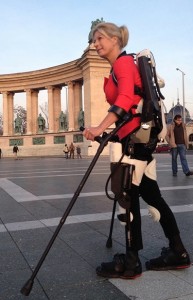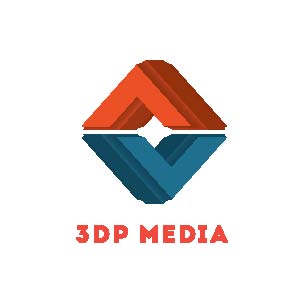Last Month I Reported On 3DP & Human Health Via The 3D-Printing Of Exo-Solutions For Non-Invasive Healthcare Mashups. Now, One Of My Examples—3D Systems Corporation’s “Ekso-Suit“—Has Won A Major Award For Superior Industrial Design…

Paralyzed former-skier Amanda Boxtel & 3D System’s “Ekso-Suit”—described by the company as the “first ever 3D printed hybrid Exoskeleton robotic suit”—demos her hyper-customized wearable robot on debut in February 2014.
3D Systems Corporation (3DS) continues to lead the 3DP Industry. And, one of the primary reasons why is President and CEO Avi Reichental’s (mostly correct) strategic market-target decisions. Avi & Co. have a knack for successfully aiming at the hottest marketplace opportunities they regularly foresee for their company.
Chief among these is 3DS’ innovative 3DP-solutions applied to the additive-manufacturing susceptible needs of the enormous worldwide Healthcare (HC) industry.
Our current 3DP-business consensus holds that Healthcare is the fastest growing sector in our industry. IDTechEx—a research house in London—projects that 3DP will be a $7 plus billion business in 2025. AND, that $3 plus billion of that will be comprised of HC-specific products and systems. Further, most of those solutions will stem from Med Sci, BioTech and HC-novel RD&D yet to be completed.
Today, the outlines of the future of 3DP in Healthcare can just be discerned. But, the indicators are broad and deep and the foment and ferment among scientists, experts and commentators extensive. Hence, prudent players in both 3DP and HC are beginning to invest in advancing the market-developing discoveries, inventions and innovations that beckon the insiders, the initiated and the in-the-know.
Avi Reichental has perfected a primary technique for garnering the technological and managerial resources to attack perceived marketplaces opportunities. That is to acquire them—lock, stock and barrel. In the last two and a half years 3DS has made over 45 3DP-related acquisitions. Many of these were HC-focused companies or those with HC-applicable solutions (e.g., geomagic/sensable).
As recently as April, Mr. Reichental’s 3DS added Medical Modeling to its stable of acquired HC companies. With that acquisition, 3DS also obtained the executive capabilities of Andy Christensen—the man who formerly ran Medical Modeling. Mr. Christensen is now Vice President of Personalized Surgery and Medical Devices at 3DS. To make the best commercial sense of his company’s HC opportunities, President Reichental has charged his new VP with effectively integrating the Healthcare assets now under roof at 3DS.
The concept of “Personalized” HC solutions is key to the gathering hyper-growth in 3DP-driven Healthcare. At last—with 3DP “one-off” flexibility in human-interface design—HC practitioners and clinicians can deliver superior medical devices because they are truly patient-specific. With personalization comes reduced costs, improved results and enhanced quality of healing. Patients—an historically grim term for the HC client—will need less patience with 3DP/HC.
Andy Christensen opines: “3D printing and scanning are allowing massive steps forward in the field of custom-designed braces that reflect and support a patient’s unique form.”
On 2 July, 3D Systems announced that two of its Bespoke design applications (extending the British term “bespoke,” or custom-built, to patient-specific: think “bespoke Rolls”) have been showcased by the 2014 International Design Excellence Awards (IDEA) from the IDSA (Industrial Design Society of America) and Core77 (an industrial design magazine and resource portal). Both the 3D printed personal Ekso robotic exoskeleton and Bespoke Braces for hand and wrist were recognized, with the Ekso being awarded Bronze in the Social Impact category.
(With this last point, it is interesting to note that 3DS also takes non-commercial stances with the social implications of 3DP applied to commonweal betterment. The company enjoys a Director of Social Impact—Ms. Leanne Gluck—who resides at the Union Square office of 3DS in New York City. Doing well by doing good CAN have corporate resonance for a public company!)
3DS VP Christensen further commented, “The work and research being done by our [HC-focused] teams represent the cutting edge in patient-specific treatments and it is satisfying to see that work being recognized for the design excellence that results.”
According to 3DS, Bespoke Braces for hand and wrist—currently in its pilot phase—is a first-of-its-kind, 3DP-driven medical solution. It enables practitioners to scan, design, and print custom hand and wrist braces. In the Bespoke Braces process, a patient’s arm is scanned and data is transmitted to cloud-based servers. There, a brace design—customized by the patient and clinician—is created to match the shape of the patient’s individual anatomy. Each brace is then 3D printed—using 3DS’ selective laser sintering (SLS) technology—for optimal comfort, flexibility and durability.
The Bespoke Braces system is comprised of an arm scanner, an iPad app, cloud software, a network of 3D printers, and four revolutionary arm brace designs. This service has recently been expanded to include custom scoliosis braces for children and young adults.
According to the Core77 Jury spokesperson, “This product is a strong example of when customization can be leveraged to its true potential, delivering an experience that is integrated, personal and a strong application of the additive manufacturing processes.”
The robotic exoskeleton—announced by 3DS in February 2014—is the first-ever, 3D-printed, hybrid-robotic exoskeleton “suit.” It was created in collaboration with Ekso Bionics of California. To create a perfect fit for Amanda Boxtel, the paraplegic patient, engineers scanned the contours of Amanda’s thighs, shins and spine. They then created a personalized three-dimensional base to form and shape the required assemblies. Sophisticated mechanical actuators and controls—manufactured and provided by Ekso Bionics—were then integrated with the more fluid components that were 3D-printed from the customized scans to create the first-ever, bespoke robotic suit.
Click here for more on Amanda’s “Suit” and other 3DS’ HC solutions.
C’mon Back!
LAND

 NYC3DPLand Tweets
NYC3DPLand Tweets